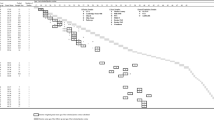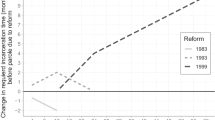Abstract
Purpose
Most criminal career research must use data with inherent limitations. Two common areas of data-imposed limitations for recidivism and desistance researchers are short observation lengths (i.e., follow-up periods) and jurisdiction-specific criminal histories. To help researchers understand the effect of data-imposed limitations, this study explores and compares the criminal career patterns observed (1) with varying follow-up periods and (2) using individuals’ jurisdictionally limited vs. national criminal history records.
Methods
This study uses criminal history data to track a sample of about 70,000 prisoners selected to represent the more than 400,000 prisoners released in 2005 from 30 states from their first arrest to 9 years after their release. Using a multivariate analysis, this study measures desistance as the cessation of arrest activity after release from prison in 2005. First, the study examines if the correlates of desistance after release from prison are consistent across 3-, 6-, and 9-year follow-up periods. Second, the study examines if the correlates of desistance are consistent when post-release data only describe arrests that occurred in the state of release from prison compared to arrests occurring within and outside the state of release (i.e., nationwide). Given their unique offending patterns and pathways to crime, separate models are presented for males and females.
Results
Those who are falsely labeled as desisters in the shorter follow-up periods or when using just in-state arrest records differ from those labeled as desisters in the more complete criminal histories.
Conclusions
This study has implications for developmental and life-course theories that rely on empirical support from limited recidivism follow-up periods and jurisdiction-specific criminal histories. By understanding the effects of data-imposed limitations of follow-up periods and geographical coverage on criminal career research, the validity of criminological theories of desistance across the life course and across place can be better measured and understood.
Similar content being viewed by others
Notes
The arrests prior to release includes arrests from national criminal history data. Examining the effect of restricting prior arrests to in-state data is an interesting research question, but is beyond the scope of this paper.
References
Alper, M., Durose, M. R., & Markman, J. (2018). 2018 update on prisoner recidivism: A 9-year follow-up period (2005–2014). Washington, DC: US Department of Justice, Office of Justice Programs, Bureau of Justice Statistics.
Andrews, D. A., Bonta, J., Wormith, J. S., Guzzo, L., Brews, A., Rettinger, J., & Rowe, R. (2011). Sources of variability in estimates of predictive validity: a specification with level of service general risk and need. Criminal Justice and Behavior, 38(5), 413–432.
Barnett, A., & Lofaso, A. J. (1985). Selective incapacitation and the Philadelphia cohort data. Journal of Quantitative Criminology, 1(1), 3–36.
Bernasco, W. (2008). Them again? Same-offender involvement in repeat and near repeat burglaries. European Journal of Criminology, 5(4), 411–431.
Blumstein, A., & Nakamura, K. (2009). Redemption in the presence of widespread criminal background checks. Criminology, 47(2), 327–359.
Blumstein, A., Farrington, D. P., & Moitra, S. (1985). Delinquency careers: innocents, desisters, and persisters. Crime and Justice, 6, 187–219.
Bushway, S. D., Nieuwbeerta, P., & Blokland, A. (2011). The predictive value of criminal background checks: do age and criminal history affect time to redemption? Criminology, 49(1), 27–60.
Durose, M. R., Cooper, A. D., & Snyder, H. N. (2014). Recidivism of prisoners released in 30 states in 2005: patterns from 2005 to 2010. Washington, DC: US Department of Justice, Office of Justice Programs, Bureau of Justice Statistics.
Durose, M. R., Snyder, H. N., & Cooper, A. D. (2015). Multistate criminal history patterns of prisoners released in 30 states. Washington, DC: US Department of Justice, Office of Justice Programs, Bureau of Justice Statistics.
Farrington, D. P. (2003). Developmental and life-course criminology: key theoretical and empirical issues-the 2002 Sutherland Award address. Criminology, 41(2), 221–225.
Fox, B. H., & Farrington, D. P. (2018). What have we learned from offender profiling? A systematic review and meta-analysis of 40 years of research. Psychological Bulletin, 144, 1247–1274.
Gendreau, P., Little, T., & Goggin, C. (1996). A meta-analysis of the predictors of adult offender recidivism: what works! Criminology, 34(4), 575–608.
Hanson, R. K., & Morton-Bourgon, K. E. (2005). The characteristics of persistent sexual offenders: a meta-analysis of recidivism studies. Journal of Consulting and Clinical Psychology, 73(6), 1154–1163.
Ihrke, D. K., & Faber, C. S. (2012). Geographical mobility: 2005 to 2010. Washington DC: US Department of Commerce, US Census Bureau.
Latimer, J., Dowden, C., & Muise, D. (2005). The effectiveness of restorative justice practices: a meta-analysis. The Prison Journal, 85(2), 127–144.
Laub, J. H., & Sampson, R. J. (2001). Understanding desistance from crime. Crime and Justice, 28, 1–69.
MacLeod, J. F., Grove, P. G., & Farrington, D. P. (2012). Explaining criminal careers: Implications for justice policy. Oxford: Oxford University Press.
Maruna, S. (1999). Desistance and development: the psychosocial process of going straight. In The British criminology conferences: selected proceedings (Vol. 2, pp. 1–19).
Maruna, S. (2001). Making good: how ex-convicts reform and rebuild their lives.
Nagin, D. S., & Land, K. C. (1993). Age, criminal careers, and population heterogeneity: specification and estimation of a nonparametric, mixed Poisson model. Criminology, 31(3), 327–362.
Smith, P., Cullen, F. T., & Latessa, E. J. (2009). Can 14,737 women be wrong? A meta-analysis of the LSI-R and recidivism for female offenders. Criminology & Public Policy, 8(1), 183–208.
Soothill, K. L., & Gibbens, T. C. (1978). Recidivism of sexual offenders: a re-appraisal. The British Journal of Criminology, 18(3), 267–276.
Townsley, M., & Sidebottom, A. (2010). All offenders are equal, but some are more equal than others: variation in journeys to crime between offenders. Criminology, 48(3), 897–917.
Visher, C. A., Winterfield, L., & Coggeshall, M. B. (2005). Ex-offender employment programs and recidivism: a meta-analysis. Journal of Experimental Criminology, 1(3), 295–316.
Wallerstedt, J. F. (1984). Returning to prison. US Department of Justice, Bureau of Justice Statistics.
Acknowledgments
The author thanks Howard Snyder and Matthew Durose for their insights and comments that greatly improved the manuscript.
Author information
Authors and Affiliations
Corresponding author
Additional information
Publisher’s Note
Springer Nature remains neutral with regard to jurisdictional claims in published maps and institutional affiliations.
The analysis and conclusions presented here are those of the author and do not necessarily represent the views and opinions of the Bureau of Justice Statistics or the U.S. Department of Justice.
Rights and permissions
About this article
Cite this article
Alper, M. Is Desistance Invariant Across Time and Geography? Examining Desistance in Released Prisoners from 30 States over 9 Years. J Dev Life Course Criminology 5, 22–37 (2019). https://doi.org/10.1007/s40865-019-0104-6
Received:
Revised:
Accepted:
Published:
Issue Date:
DOI: https://doi.org/10.1007/s40865-019-0104-6




